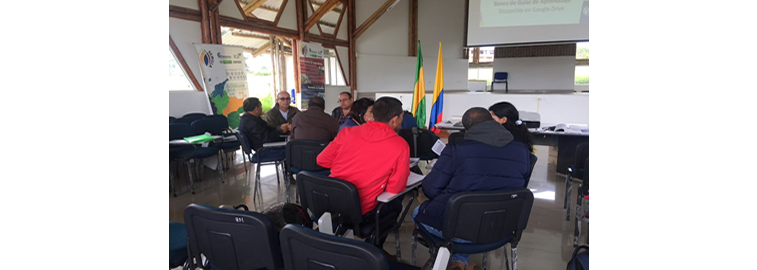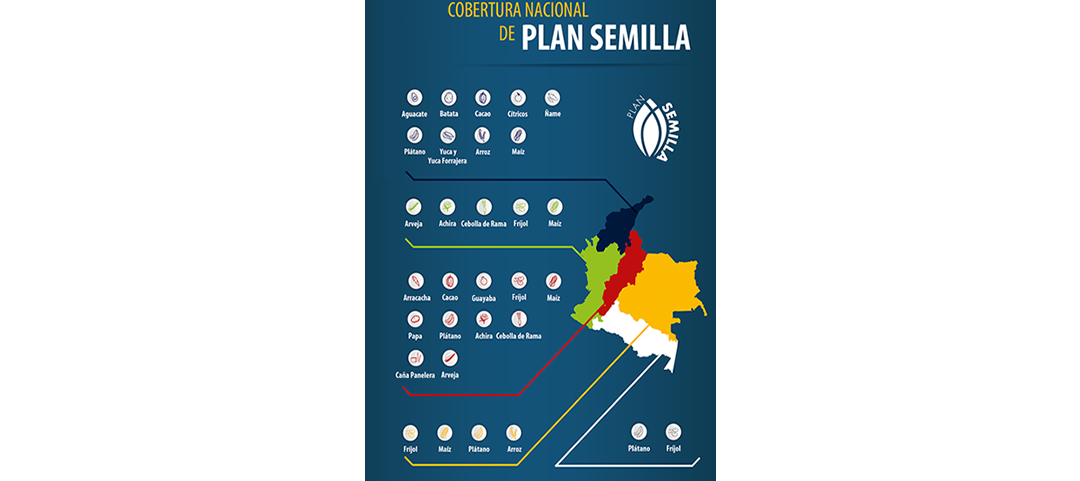Quality Seeds
National Seed Plan
Culturally, the seed has an important role as food and raw material in the productive processes of agriculture and agro-industry; therefore, the concept of "Quality Seed" must be integrated into the production of seed or propagation material to ensure success in all its forms of consumption and for the sustainability of species and varieties over time. From this perspective, the Colombian Agricultural Research Corporation (AGROSAVIA) appropriates the concept and implements it through the work carried out by the Seed Department and the innovation networks. The seed department is in charge of managing and administering the production processes. of quality seed in the corporation.
In this sense, the inter-institutional strategy called "National Seed Plan" is presented, which seeks to recover, conserve and improve with the organizations associated with the project the use of the seed resource, which allows the availability of plant material in quality and quantity for the use in two scenarios; food safety and conservation. In this space, it is presented how it was forged from its beginning to its present, news about the project and the characteristics of the species and materials associated with the National Seed Plan. The contents are presented in a comfortable and intuitive way for consultation and navigation, which facilitates the consultation of producers, extension agents, technical assistants and other public that is interested in obtaining information related to the project.

¿What is quality seed?
Seed quality cannot be defined as a variable with a specific value, since it is a set of desirable characteristics as a result of the sum of 4 components or intrinsic attributes of seed quality (genetic, physical, physiological and sanitary). ) that confer an aptitude, convenience or degree of superiority of the material to carry out a subsequent sowing process.
¿What is the National Seed Plan?
The National Seed Plan is a commitment to inter-institutional cooperation between AGROSAVIA, ICA, and SENA that seeks to link quality plant material in the productive sector. Also, to recover, conserve and improve with the communities the use of plant genetic resources for small agricultural producers. In this way, the National Seed Plan has managed to have an impact in the following six (6) areas:
- Recovery of plant genetic resources of rural communities.
- Renovation of crop areas.
- Expansion of new areas and/or repopulation of plant material.
- Provide support to industrial chains.
- Support agro-export processes.
- Contribute to food security and sovereignty in communities.
The National Seed Plan worked with 20 productive species of importance for the peasant economy and national food security through a scheme of recovery, cleaning, multiplication, scaling and provision of regional and/or improved materials according to community demands. Simultaneously, it sought to generate capacities in the affiliated organizations to consolidate them as productive nuclei of quality seed that can be supplied by the same associations in their region or in other regions of Colombia.

Background
On the occasion of the Winter Wave that the country faced between 2010 and 2012, the National Government generated contingency plans and designed methodologies to rehabilitate flooded soils and assist the affected population in the short term. With resources from Colombia Humanitaria, assistance was achieved to around 20,000 families out of the 80,000 that lost their food crops.
As a result of the institutional learning, the need to develop a medium- and long-term process with a wide scope was identified to solve the market failures observed in the commercialization of seeds, the low quality and scarce availability of the same for small producers.
From there, the National Seed Plan was born, which seeks to reactivate the production of quality seed for species of economic importance and food security, strengthening organizations of small producers in order for them to consolidate themselves as seed producers.
Photo credit: Special to 90minutos.co
Goals
General
Contribute to the reactivation of the national seed production system through the consolidation of the restitution and/or reinforcement of the production of quality seeds with improved and regional materials for peasant farming communities. To this end, the consolidation of local multiplication centers will be continued in participatory processes that ensure their availability over time. The adoption of technology will be promoted through the Technical Assistance program led by the Ministry of Agriculture and Rural Development.
Specifics
The National Seed Plan in its projection to five (5) years proposed the following specific objectives.
- Recovery, conservation and use of plant genetic resources by and for small producers.
- Maintain a quality seed stock of economically important species adapted to climatic conditions according to the environment of rural communities.
- Consolidate the current state of conservation, production use and commercialization.
- Advance processes of technological updating on the use, production, management and commercialization.
- Consolidate high-quality seed production nuclei in local multiplication centers with improved and regional materials.
Coverage
The National Seed Plan has an influence on 20 productive species of importance for the peasant economy and National food security, making a presence in the five (5) regions of the Colombian territory, 23 departments and in more than 150 municipalities with the consolidation of productive nuclei.

Impacts
- In the guava species Psidium guajava L., the red regional guava and white regional guava ecotypes were multiplied in the departments of Boyacá and Santander.
- Seven organizations from the departments of Boyacá and Santander received 1,100 grafted plants of regional red and white guava and established 10 mother orchards that they use for internal consumption and for the sale of plant material.
- The Aprocogua organization of the municipality of Guavatá, department of Santander, registered as a producer of quality guava trees with the Colombian Agricultural Institute ICA.
- The APROCOGUA organization has agribusiness plans built jointly between AGROSAVIA and SENA, as a guiding tool in future production processes.
- Indicators, this agro-industry processes around 25,000 t in 131 factories, generates income close to one billion pesos annually and benefits 15,000 families.
- Strategies were developed to identify production costs.
- Training workshops Two updating workshops were held for instructors from Boyacá and Santander in the sexual and asexual multiplication of guava plant material at the nursery level.
- Total deliveries 40,000 guava trees were delivered to the associations registered in the National Guava Seed Plan as a strategy to increase technical crops of this species, expanding the area.
- Publications the technical sheets of the red regional guava and white regional guava were built, the TECHNICAL MANUAL is in adjustment: Production of sexual and asexual seeds (seedlings) of guava Psidium guajava L. under the agroecological conditions of the Hoya del Rio Suarez, in the departments of Boyacá and Santander.
Internal traceability system (SIT)
The Internal Traceability System (SIT) is a computer tool that allows monitoring of the quality seed production process, by integrating in a competitive manner the set of activities, the flow channels of the species associated with the National Seed Plan (PS ) and the users involved throughout the value chain, in order to properly manage the traceability of each batch produced. Therefore, AGROSAVIA is a pioneer in the implementation of a traceability system for the production of quality seed in Colombia.
Achievements
The architecture developed for the SIT provided a comprehensive vision of the history, location, trajectory, distribution and monitoring of the batch of grain seed or propagation plant material according to the particularities of the productive species associated with the National Seed Plan. at a given moment, improving the quality, relevance and efficiency in decision-making in the face of real logistics problems; thus achieving, adding value to the Research Centers (C.I) and productive units of the producer organizations receiving initial material, improving relationships with suppliers, optimizing internal technical processes and reducing the production costs of distributed plant material. In the same way, the flow of information from the PS will be streamlined in a practical, effective and sustainable way in a single information channel.
Continuity of the National Seed Plan
“PROGRAM TO STRENGTHEN THE NATIONAL SEED SYSTEM AND TO SUPPORT LOCAL SEED PRODUCTION SYSTEMS WITH SMALL AND MEDIUM FARMERS”
The National Seed Plan in its initial version managed to strengthen the supply of quality seeds and benefit a wide diversity of agricultural crops in the Colombian territory, working on the consolidation of local multiplication models with producers. But this work did not end there, since the success of the first results will be consolidated with the continuity of the program and the expansion of its scope, given the great diversity of species, varieties and territories that will be served by AGROSAVIA and its strategic allies.
The goals set forth in this program respond to the corporate objective of transferring technological innovation processes in the Agricultural sector, for which AGROSAVIA, with the support of the Ministry of Agriculture and Rural Development, approved the continuity of the National Seed Plan for the next 5 years, with in order to reactivate local seed production systems, through the rescue of native and Creole materials and the transfer of improved materials, to work directly with organizations of small seed producers.
Objective
Implement strategies that allow the development, strengthening, and consolidation of local seed production systems based on the rescue and conservation of native and Creole materials and the linkage of varieties from genetic breeding programs to complement the national seed system through quality seed production.




